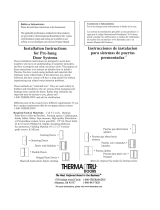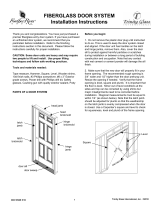Page is loading ...

TOOLS NEEDED
• 4’ level (digital best) • Tape Measure
• 90 degree steel square • Rubber mallet
• Screw gun & 3/32” drill bit • Caulking gun
• Screwdriver
MATERIALS NEEDED
• #10x2 1/4” wood (drywall) screws (12 per single, 14
per unit w/sidelites - small head screws required for
units as holes will need to be filled with putty and
stained to conceal)
• Caulking: clear siliconized acrylic caulking (50 year
best)
• Wood shims (1 pack of at least 20 pcs)
BEFORE INSTALLING
1. Check overhang to
ensure adequate
protection from
weather elements
(figure 1). Your new wood door is
a piece of furniture and should be
treated as such.
2. Check new door for any defects
PRIOR to installation! Double
check desired door swing.
Exterior doors swing to inside.
Left hand doors will have handleset holes on right
side if looking at the door from the outside. Right
hand doors will have the holes on the left side on the
door.
3. Remove old door and frame (interior casing and
exterior trim must be removed).
4. Check Rough Opening Framing-
The rough opening for your door should be minimum
1/2” larger than door frame width on each side and
1/2” taller than door frame height.
Check to make
sure your opening
is plumb and
square (level front
to back vertically
and level header
as well as side to
side) (figure 2). If
one side of the
wall opening
leans out and
other side leans
in, the door will be twisted and not work properly if
not addressed. This issue should be addressed prior
to install of door). Minor issues (1/16”) will be
addressed with the wood shims.
INSTALLING YOUR NEW PACIFIC CREST DOOR
1. Remove door slab from frame by removing plastic
strike keeper and either removal of the hinges
themselves or the hinge pins. DO NOT drag the
door on floor right side up as the bottom sweep on
the door will be damaged. Door should be set upside
down to avoid this issue.
2. If exterior trim has been installed (brickmold), make
sure to handle with care as to not damage the finish.
In step 5, apply caulking bead behind the brickmold
prior to placing the
door frame in the
opening. The
frame can be
placed in the
opening for a “dry
fit” (figure 3) to
ensure the
brickmold trim fits
between inside the
siding. Siding may
need trimming for
proper fit.
Entry Door
Installation Instructions
READ ALL INSTRUCTIONS PRIOR TO STARTING!
Figure 1
- continued -
HEADER
is wall straight? (check top, middle, bottom)
diagonals should be equal
is opening front, side and oor level & square?
Figure 2
brickmold
dry t
to ensure
proper
t
rev. 8-27-14
Figure 3

3. Remove weatherstrip from jambs,
both sides and head (figure 4)
(NOT NECESSARY IF INSTALLING
A DOOR UNIT WITH SIDELITES).
4. Drill 4 holes on each side and 2
holes in head of door frame (figure 5),
to accommodate installation screws.
First hole and last hole should be 4”
from corners (head as well). Drill 2
more holes on each side equal distance
from corner holes. Holes should be
drilled on thinner side of wood so
weatherstrip will cover when complete
(figure 4). For units with sidelites, holes
will need 3/16” countersink to avoid
wood tear out. Unit holes will need to
be puttied and stained when install
finished.
5. Put a generous bead of
caulk along the outside
edge of the subfloor and
another 1/2” in from the
first (figure 6). Be sure
the caulking bead
creates a seal between
the door sill and the
subfloor to prevent any
water infiltration.
6. From the outside, tilt the
entire door frame into the
center of the opening.
With wood shim behind
the predrilled hole in the
hinge jamb, install
middle screw on hinge
side though the jamb into
the stud (figure 7). Repeat
other hinge-side screws,
maintaining level in both
vertical and front to back planes (plumb). Note if walls
are not vertical, exterior brickmold trim may not touch
in all areas. Do NOT attempt to flush trim against
exterior wall as this could result in
poor door performance.
7. Replace two of the top hinge screws
with 2 1/4” screws (figure 8). Screws
must penetrate actual stud to ensure
door does not sag.
8. Install door back into door jamb.
9. With door shut, install wood shims behind predrilled
holes making sure all areas have equal spacing
between door and frame (figure 9). Frame should also
be flush with the door from top to bottom. Once all
shims are in place with proper
alignment, install all remaining
screws.
10. Deadbolt hardware plate should
be backed by solid shims (or
small piece of hardwood) and 2
1/4” screws should be used to
secure the deadbolt face plate.
11. Make sure door sweep is
contacting the sill evenly. The sill
cap can be adjusted if needed. A
clockwise turn raises the sill cap
(figure 11).
12. For doors with sidelite units,
remove sill cap and place 2
additional screws through the
composite of the sill into the
subfloor. If the subfloor is
concrete, a construction
adhesive should be used in
addition to the caulking
previously mentioned in step 5.
13. Installation is complete. Exterior
(if brickmold not installed) and
interior trim can now be
attached. Additional caulking
should be placed between the
trim the siding or brick as well
as the front edge of the door sill. Stucco or other
exterior siding finishes should overlap the door frame.
14. Storm doors should not be used as the cause excess
heat build-up that will damage the door and void
warranty.
15. Failure to follow proper installation instructions will
void the warranty.
16. Note: NEVER pressure wash your entry door. The high
pressure water can actually damage the wood. As
well, wood doors have floating panels (not sealed so
they can continue to move with climate changes). The
result will be water penetration to the interior of your
home.
rev. 8-27-14
Figure 4
Figure 8
Figure 10
Figure 11
Figure 9
Figure 5
Figure 6
OUTSIDE
wood
shims
2-1/4”
screw
wood
shim
stud
up
down
Figure 7
shims
between
hinge
jamb
and stud
ensure door is plumb & square
check
corners
drill holes
minimum
4” from
corners
4”
4”
4”
4”
weatherstrip
hole
placement
4”
1/2”
apart
OUTSIDE
2-1/4”
screws
stud
/








